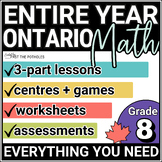Financial Literacy Ontario Grade 8 Math Unit Budget Simple & Compound Interest
- PDF
- Google Apps™
- Easel Activity

What educators are saying
Also included in
- Grade 8 Ontario math teachers! You'll love our long-range plans, detailed 3-part lessons, Ontario math report card comments, practice worksheets, review activities, assessments, tracking sheets and more.Units included are: First 20 Days, Number Sense, Operations, Patterning, Algebra, Coding, GeometrPrice $115.00Original Price $220.48Save $105.48
- Ontario Math teachers. LOVE these units for Number Sense & Numeracy, Coding, Financial Literacy, Data Management, Probability, Location & Movement, Geometric Reasoning, Algebra, Patterning, and Measurement. Includes Google Slides lessons, hands-on activities, practice worksheets, math centrePrice $180.00Original Price $373.48Save $193.48
Description
This Grade 8 Ontario Personal Financial Literacy unit covers budgeting, simple interest, compound interest, sales tax, credit cards, consumer contracts, and setting financial goals. This low-prep unit includes Google Slides Financial Literacy lessons, worksheets, activities, games and assessments.
Our units encourage students to use and develop their Knowledge, Application, Thinking, and Communication skills in a way that will prepare them for success in grade 9.
This unit is part of our ENTIRE YEAR OF GRADE 8 ONTARIO MATH PACKAGE which includes all of our math resources for Grade 8.
"Best resource I've ever purchased! Comprehensive like you cannot imagine. An incredible value!"
buyer of Entire Year Package
WHAT'S INCLUDED?
UNIT OUTLINE (Available in the Preview)
LESSON PLANS (Sample lesson included in Preview)
- Ontario Curriculum
- 3-part format including expectations, learning goals, examples, minds on activities, action activities, extension/discussion activities, and consolidation activities.
- Review Lesson: Calculating costs including sales tax
- Lesson 1: Comparing different payment methods
- Lesson 2: Planning for long-term financial goals
- Lesson 3: Balancing a budget
- Lesson 4: Simple and compound interest
- Lesson 5: Helping consumers get more value
- Lesson 6: Comparing credit cards and consumer contracts
UNIT WORKSHEETS (2021 update) (Sample page in Preview)
Upon request, we created a workbook that addresses each curriculum expectation. Teachers can print the sheets for their students or share them directly in their digital classroom.
2022 Update: We've created a self-checking version of the workbook using Easel.
STATIONS (CENTRES)
Give your students a chance to work on the material in a different way. I use this as an opportunity to spend some time with GUIDED GROUPS (Questions included) for the first half of the period and monitor/assess during the second half of the period. If you have a challenging class, this can be a difficult routine to establish, but well worth the effort!
- Ordering lunch (sales tax and tip)
- Daily expenses (budget)
GROUP ACTIVITIES
- Bingo
- SWAT!
CULMINATING ACTIVITY
- The assignment requires students to examine bank accounts, credit cards, and mortgage options. They are encouraged to share the pros and cons of at least 3 options and determine which would be the 'best fit'.
TRACKING TEMPLATES to help you record student learning and grades.
RELATED PRODUCTS
We have a huge selection of report card resources.
Grade 8 Ontario Report Card Comments Package - All Subjects & Learning Skills
Save time and money by purchasing this bundle including ALL grade 8 math units.
ENTIRE YEAR OF ONTARIO MATH PACKAGE - GRADE 8
If you would prefer specific units, we have them available individually and bundled by strand.
_________________________________________________________________________________________








